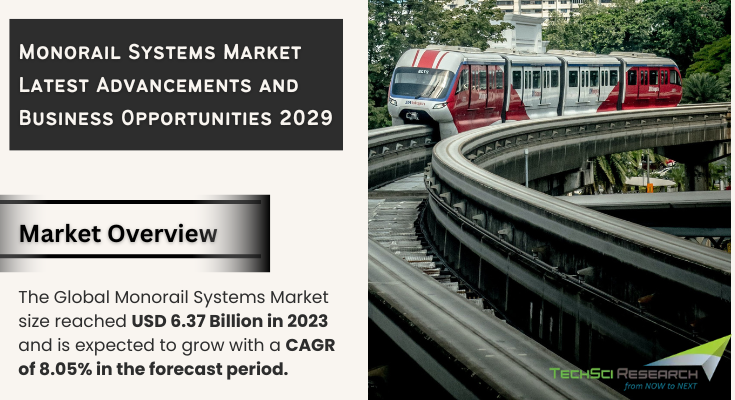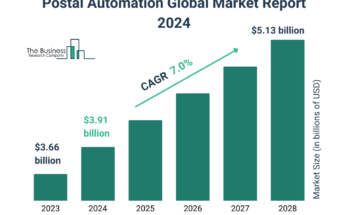According to TechSci Research report, “Monorail Systems Market – Global Industry Size, Share, Trends, Competition Forecast & Opportunities, 2029”, The Global Monorail Systems Market stood at USD 6.37 Billion in 2023 and is anticipated to grow with a CAGR of 8.05% in the forecast period, 2025-2029. The Global Monorail Systems Market has witnessed significant growth and evolution, playing a pivotal role in addressing the escalating challenges of urban mobility and congestion. Monorail systems, characterized by elevated tracks and streamlined vehicles, have become integral components of modern urban transit solutions. The market’s trajectory is shaped by a confluence of factors.
Key to the market’s growth is the increasing urbanization and population density in major metropolitan areas worldwide. As cities grapple with rising traffic congestion, environmental concerns, and the need for efficient mass transit, monorail systems have emerged as a compelling solution. Their elevated design minimizes ground-level disruptions, making them suitable for navigating densely populated urban landscapes and offering an effective alternative to traditional modes of transportation.
Technological advancements are driving innovation in the Global Monorail Systems Market. The integration of advanced technologies, such as magnetic levitation (Maglev), automation, and smart city solutions, enhances the efficiency, safety, and sustainability of monorail networks. Maglev technology reduces friction, enabling smoother and faster transportation, while automation contributes to optimized operations and maintenance.
The market’s appeal is further heightened by the cost-effectiveness of monorail construction compared to traditional rail systems. The elevated nature of monorail tracks allows for minimal disruption to existing infrastructure and ground-level traffic, making them a preferred choice for cities seeking rapid and efficient transit solutions. Additionally, the ability of monorail systems to navigate tight urban spaces and provide last-mile connectivity contributes to their widespread adoption.
Government initiatives and public-private partnerships (PPPs) play a pivotal role in fueling the growth of the Global Monorail Systems Market. Governments worldwide are recognizing the benefits of monorail technology in promoting sustainable urban development and investing in expansive infrastructure projects. Collaborations with private entities help address funding challenges and facilitate the efficient execution of monorail projects.
In summary, the Global Monorail Systems Market is characterized by a dynamic interplay of urbanization trends, technological innovation, cost-effectiveness, and government support. Monorail systems are not only addressing immediate transportation challenges but are also shaping the future of smart, sustainable, and efficient urban mobility on a global scale. The market’s trajectory is expected to continue evolving as cities increasingly prioritize innovative transit solutions to meet the demands of urban growth.
Browse over market data Figures spread through 180 Pages and an in-depth TOC on “ Global Monorail Systems Market.” @ https://www.techsciresearch.com/report/monorail-systems-market/22224.html
In North America, the adoption of monorail systems varies across regions, with notable projects in places like Las Vegas and Seattle. While traditional rail systems dominate many urban transit networks, some cities have shown interest in monorails for their efficiency and unique design. The potential for further adoption depends on overcoming challenges related to integrating monorails with existing infrastructure and established transportation modes. As cities increasingly focus on sustainable transit options, the market for monorail systems may see growth, especially in regions where urban planning allows for their effective integration.
Europe has been at the forefront of embracing monorail systems, with countries like Germany and France successfully integrating them into their transit networks. The Wuppertal Suspension Railway in Germany stands as an iconic example of a suspended monorail, blending seamlessly with the historical and architectural character of the region. European cities, known for their emphasis on public transit and sustainability, are increasingly considering monorail options to address urban mobility challenges. The emphasis on efficient, environmentally friendly transportation aligns with the goals of many European cities, making monorail systems a compelling choice for certain urban corridors.
The Asia-Pacific region has emerged as a powerhouse for monorail development, driven by rapid urbanization and a pressing need for efficient mass transit. Countries like China and Japan have spearheaded extensive monorail networks, with straddle monorails playing a crucial role in connecting urban and suburban areas. The seamless integration of monorail systems into these countries’ broader transit plans reflects a strategic approach to address population density and promote sustainable urban development. The continued expansion of cities in countries like India is expected to fuel the demand for monorail solutions, presenting a significant growth opportunity in the Asia-Pacific region.
In the Middle East, countries like the United Arab Emirates have demonstrated a strong commitment to futuristic urban planning, including the implementation of monorail systems. The Palm Jumeirah Monorail in Dubai serves as a notable example, providing efficient connectivity for residents and tourists. The region’s investment in cutting-edge infrastructure aligns with its vision for smart cities and sustainable transportation. In Africa, interest in monorail systems is growing, with potential projects in countries like Nigeria. The emphasis on economic development and improved connectivity positions monorails as a viable solution for addressing urban transit challenges in the Middle East and Africa.
Major companies operating in the Global Monorail Systems Market are:
- Scomi Engineering Bhd
- Siemens AG
- Bombardier Inc.
- Hitachi, Ltd.
- CSR Corporation Limited
- Mitsubishi Heavy Industries Ltd.
- Urbanaut Monorail Technology
- Aerobus International, Inc.
To Download FREE Sample Pages of this Report📥 @ https://www.techsciresearch.com/sample-report.aspx?cid=22224
Customers can also request 10% free customization in this report.
“The Global Monorail Systems Market is experiencing a transformative phase driven by the urgent need for sustainable urban transit solutions. The integration of advanced technologies, coupled with government support and public-private partnerships, is reshaping urban mobility landscapes. Monorail systems, with their cost-effectiveness, minimal environmental impact, and potential for innovation, are positioned as key players in addressing the evolving challenges of modern urbanization,” said Mr. Karan Chichi, Research Director with TechSci Research, a research-based management consulting firm.
“Monorail Systems Market – Global Industry Size, Share, Trends Opportunity, and Forecast, Segmented By Monorail Type (Straddle and Suspended), By Propulsion Type (Electric and Magnetic Levitation), By Size (Large, Medium and Compact), By Region, Competition, 2019-2029”, has evaluated the future growth potential of Global Monorail Systems Market and provides statistics & information on market size, structure, and future market growth. The report intends to provide cutting-edge market intelligence and help decision-makers take sound investment decisions. Besides, the report also identifies and analyzes the emerging trends along with essential drivers, challenges, and opportunities in the Global Monorail Systems Market.
You may also read:
Flexible Shaft Couplings Market – Size, Share, Trends, In-Depth Insights 2029
Sintered Brake Pads Market Analysis, Development [2029], Key Terms
Electric Kick Scooter Market [2029]- A Deep Dive into the Latest Market Trends, Market Segmentation
Table of Content-Monorail Systems Market
- Introduction
1.1. Product Overview
1.2. Key Highlights of the Report
1.3. Market Coverage
1.4. Market Segments Covered
1.5. Research Tenure Considered
- Research Methodology
2.1. Objective of the Study
2.2. Baseline Methodology
2.3. Key Industry Partners
2.4. Major Association and Secondary Sources
2.5. Forecasting Methodology
2.6. Data Triangulation & Validation
2.7. Assumptions and Limitations
- Executive Summary
3.1. Market Overview
3.2. Market Forecast
3.3. Key Regions
3.4. Key Segments
- Impact of COVID-19 on Global Monorail Systems Market
- Global Monorail Systems Market Outlook
5.1. Market Size & Forecast
5.1.1. By Value
5.2. Market Share & Forecast
5.2.1. By Monorail Type Market Share Analysis (Straddle and Suspended)
5.2.2. By Propulsion Type Market Share Analysis (Electric and Magnetic Levitation)
5.2.3. By Size Market Share Analysis (Large, Medium and Compact)
5.2.4. By Regional Market Share Analysis
5.2.4.1. Asia-Pacific Market Share Analysis
5.2.4.2. Europe & CIS Market Share Analysis
5.2.4.3. North America Market Share Analysis
5.2.4.4. South America Market Share Analysis
5.2.4.5. Middle East & Africa Market Share Analysis
5.2.5. By Company Market Share Analysis (Top 5 Companies, Others – By Value, 2023)
5.3. Global Monorail Systems Market Mapping & Opportunity Assessment
5.3.1. By Monorail Type Market Mapping & Opportunity Assessment
5.3.2. By Propulsion Type Market Mapping & Opportunity Assessment
5.3.3. By Size Market Mapping & Opportunity Assessment
5.3.4. By Regional Market Mapping & Opportunity Assessment
- Asia-Pacific Monorail Systems Market Outlook
6.1. Market Size & Forecast
6.1.1. By Value
6.2. Market Share & Forecast
6.2.1. By Monorail Type Market Share Analysis
6.2.2. By Propulsion Type Market Share Analysis
6.2.3. By Size Market Share Analysis
6.2.4. By Country Market Share Analysis
6.2.4.1. China Market Share Analysis
6.2.4.2. India Market Share Analysis
6.2.4.3. Japan Market Share Analysis
6.2.4.4. Indonesia Market Share Analysis
6.2.4.5. Thailand Market Share Analysis
6.2.4.6. South Korea Market Share Analysis
6.2.4.7. Australia Market Share Analysis
6.2.4.8. Rest of Asia-Pacific Market Share Analysis
6.3. Asia-Pacific: Country Analysis
6.3.1. China Monorail Systems Market Outlook
6.3.1.1. Market Size & Forecast
6.3.1.1.1. By Value
6.3.1.2. Market Share & Forecast
6.3.1.2.1. By Monorail Type Market Share Analysis
6.3.1.2.2. By Propulsion Type Market Share Analysis
6.3.1.2.3. By Size Market Share Analysis
6.3.2. India Monorail Systems Market Outlook
6.3.2.1. Market Size & Forecast
6.3.2.1.1. By Value
6.3.2.2. Market Share & Forecast
6.3.2.2.1. By Monorail Type Market Share Analysis
6.3.2.2.2. By Propulsion Type Market Share Analysis
6.3.2.2.3. By Size Market Share Analysis
6.3.3. Japan Monorail Systems Market Outlook
6.3.3.1. Market Size & Forecast
6.3.3.1.1. By Value
6.3.3.2. Market Share & Forecast
6.3.3.2.1. By Monorail Type Market Share Analysis
6.3.3.2.2. By Propulsion Type Market Share Analysis
6.3.3.2.3. By Size Market Share Analysis
6.3.4. Indonesia Monorail Systems Market Outlook
6.3.4.1. Market Size & Forecast
6.3.4.1.1. By Value
6.3.4.2. Market Share & Forecast
6.3.4.2.1. By Monorail Type Market Share Analysis
6.3.4.2.2. By Propulsion Type Market Share Analysis
6.3.4.2.3. By Size Market Share Analysis
6.3.5. Thailand Monorail Systems Market Outlook
6.3.5.1. Market Size & Forecast
6.3.5.1.1. By Value
6.3.5.2. Market Share & Forecast
6.3.5.2.1. By Size Market Share Analysis
6.3.5.2.2. By Propulsion Type Market Share Analysis
6.3.5.2.3. By Size Market Share Analysis
6.3.6. South Korea Monorail Systems Market Outlook
6.3.6.1. Market Size & Forecast
6.3.6.1.1. By Value
6.3.6.2. Market Share & Forecast
6.3.6.2.1. By Monorail Type Market Share Analysis
6.3.6.2.2. By Propulsion Type Market Share Analysis
6.3.6.2.3. By Size Market Share Analysis
6.3.7. Australia Monorail Systems Market Outlook
6.3.7.1. Market Size & Forecast
6.3.7.1.1. By Value
6.3.7.2. Market Share & Forecast
6.3.7.2.1. By Monorail Type Market Share Analysis
6.3.7.2.2. By Propulsion Type Market Share Analysis
6.3.7.2.3. By Size Market Share Analysis




